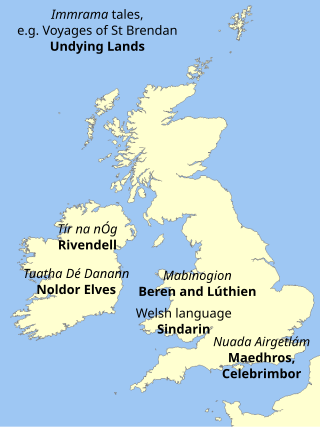Related Research Articles

The Cirth is a semi‑artificial script, based on real‑life runic alphabets, one of several scripts invented by J. R. R. Tolkien for the constructed languages he devised and used in his works. Cirth is written with a capital letter when referring to the writing system; the letters themselves can be called cirth.

The Tengwar script is an artificial script, one of several scripts created by J. R. R. Tolkien, the author of The Lord of the Rings.
The Elvish languages of Middle-earth, constructed by J. R. R. Tolkien, include Quenya and Sindarin. These were the various languages spoken by the Elves of Middle-earth as they developed as a society throughout the Ages. In his pursuit for realism and in his love of language, Tolkien was especially fascinated with the development and evolution of language through time. Tolkien created two almost fully developed languages and a dozen more in various beginning stages as he studied and reproduced the way that language adapts and morphs. A philologist by profession, he spent much time on his constructed languages. In the collection of letters he had written, posthumously published by his son, Christopher Tolkien, he stated that he began stories set within this secondary world, the realm of Middle-earth, not with the characters or narrative as one would assume, but with a created set of languages. The stories and characters serve as conduits to make those languages come to life. Inventing language was always a crucial piece to Tolkien's mythology and world building. As Tolkien stated:
The invention of languages is the foundation. The 'stories' were made rather to provide a world for the languages than the reverse. To me a name comes first and the story follows.
The English philologist and author J. R. R. Tolkien created several constructed languages, mostly related to his fictional world of Middle-earth. Inventing languages, something that he called glossopoeia, was a lifelong occupation for Tolkien, starting in his teens.
Eärendil the Mariner and his wife Elwing are characters in J. R. R. Tolkien's Middle-earth legendarium. They are depicted in The Silmarillion as Half-elven, the children of Men and Elves. He is a great seafarer who, on his brow, carried the Morning Star, a jewel called a Silmaril, across the sky. The jewel had been saved by Elwing from the destruction of the Havens of Sirion. The Morning Star and the Silmarils are elements of the symbolism of light, for divine creativity, continually splintered as history progresses. Tolkien took Eärendil's name from the Old English name Earendel, found in the poem Crist A, which hailed him as "brightest of angels"; this was the beginning of Tolkien's Middle-earth mythology. Elwing is the granddaughter of Lúthien and Beren, and is descended from Melian the Maia. Through their progeny, Eärendil and Elwing became the ancestors of the Númenorean, and later Dúnedain, royal bloodline.
The Black Speech is one of the fictional languages constructed by J. R. R. Tolkien for his legendarium, where it was spoken in the evil realm of Mordor. In the fiction, Tolkien describes the language as created by Sauron as a constructed language to be the sole language of all the servants of Mordor.
In J. R. R. Tolkien's legendarium, the Elves or Quendi are a sundered (divided) people. They awoke at Cuiviénen on the continent of Middle-earth, where they were divided into three tribes: Minyar, Tatyar and Nelyar. After some time, they were summoned by Oromë to live with the Valar in Valinor, on Aman. That summoning and the Great Journey that followed split the Elves into two main groups, which were never fully reunited.
The Elvish Linguistic Fellowship is a "Special Interest Group" of the Mythopoeic Society devoted to the study of J. R. R. Tolkien's constructed languages, headed by the computer scientist Carl F. Hostetter. It was founded by Jorge Quiñónez in 1988.
The works of J. R. R. Tolkien have generated a body of research covering many aspects of his fantasy writings. These encompass The Lord of the Rings and The Silmarillion, along with his legendarium that remained unpublished until after his death, and his constructed languages, especially the Elvish languages Quenya and Sindarin. Scholars from different disciplines have examined the linguistic and literary origins of Middle-earth, and have explored many aspects of his writings from Christianity to feminism and race.
This is a list of all published works of the English writer and philologist J. R. R. Tolkien. Tolkien's works were published before and after his death.
The Maiar are a fictional class of beings from J. R. R. Tolkien's high fantasy legendarium. Supernatural and angelic, they are "lesser Ainur" who entered the cosmos of Eä in the beginning of time. The name Maiar is in the Quenya tongue from the Elvish root maya- "excellent, admirable".
In J. R. R. Tolkien's writings, Elves are the first fictional race to appear in Middle-earth. Unlike Men and Dwarves, Elves are immortal, though they can be killed in battle. If so, their souls go to the Halls of Mandos in Aman. After a long life in Middle-earth, Elves yearn for the Earthly Paradise of Valinor, and can sail there from the Grey Havens. They feature in The Hobbit and The Lord of the Rings. Their history is described in detail in The Silmarillion.

Quenya is a constructed language, one of those devised by J. R. R. Tolkien for the Elves in his Middle-earth fiction.
Sindarin is one of the constructed languages devised by J. R. R. Tolkien for use in his fantasy stories set in Arda, primarily in Middle-earth. Sindarin is one of the many languages spoken by the Elves. The word Sindarin is a Quenya word.
Quenya is a constructed language devised by J. R. R. Tolkien, and used in his fictional universe, Middle-earth.
J. R. R. Tolkien was both a philologist and an author of high fantasy. He had a private theory that the sound of words was directly connected to their meaning, and that certain sounds were inherently beautiful. Scholars believe he intentionally chose words and names in his constructed Middle-earth languages to create feelings such as of beauty, longing, and strangeness. Tolkien stated that he wrote his stories to provide a setting for his languages, rather than the other way around. Tolkien constructed languages for the Elves to sound pleasant, and the Black Speech of the evil land of Mordor to sound harsh; poetry suitable for various peoples of his invented world of Middle-earth; and many place-names, chosen to convey the nature of each region. The theory is individual, but it was in the context of literary and artistic movements such as Vorticism, and earlier nonsense verse that stressed language and the sound of words, even when the words were apparently nonsense.
Tolkien's scripts are the writing systems invented by the philologist and fantasy author J. R. R. Tolkien. The best-known are Cirth, Sarati, and Tengwar.

Tom Loback was an artist, known for his illustrations of characters from J. R. R. Tolkien's 1977 book The Silmarillion, his miniature figurines, and his public artworks in New York. He contributed also as a Tolkien scholar interested in Tolkien's constructed languages.

J. R. R. Tolkien derived the characters, stories, places, and languages of Middle-earth from many sources. Among these are the Celtic legends and languages, which for Tolkien were principally Irish and Welsh. He gave multiple conflicting reasons for his liking for Welsh. Tolkien stated directly that he had made use of Welsh phonology and grammar for his constructed Elvish language Sindarin. Scholars have identified multiple legends, both Irish and Welsh, as likely sources of some of Tolkien's stories and characters; thus for example the Noldorin Elves resemble the Irish Tuatha Dé Danann, while the tale of Beren and Lúthien parallels that of the Welsh Culhwch and Olwen. Tolkien chose Celtic names for the isolated settlement of Bree-land, to distinguish it from the Shire with its English names.

Philology, the study of comparative and historical linguistics, especially of the medieval period, had a major influence on J. R. R. Tolkien's fantasy world of Middle-earth. He was a professional philologist, and made use of his knowledge of medieval literature and language to create families of Elvish languages and many details of the invented world.
References
- ↑ Carpenter, Humphrey; Tolkien, Christopher (1981). The Letters of J. R. R. Tolkien. United Kingdom: George Allen & Unwin. Letter No. 165. ISBN 0-04-826005-3.
- ↑ From a letter to W. R. Matthews, dated 13–15 June 1964, published in Parma Eldalamberon (17), p. 135.
- ↑ J. R. R. Tolkien, "Tengwesta Qenderinwa", Parma Eldalamberon 18, p. 72
- ↑ Solopova, Elizabeth (2009). Languages, Myths and History: An Introduction to the Linguistic and Literary Background of J. R. R. Tolkien's Fiction. New York City: North Landing Books. "Invented Languages". ISBN 978-0-9816607-1-4.
- 1 2 "More of the 'Rings' magic". USA Today . 20 January 2004.
- ↑ Ruszkowski, Marek (2004). Wielojęzyczność w perspektywie stylistyki i poetyki. Wydawnictwo Akademii Swiętokrzyskiej. p. 98. ISBN 83-7133-232-7.
- ↑ "Projekt słownika Starszej Mowy". Archived from the original on 24 March 2014. Retrieved 6 March 2013.
- ↑ "Fantasy Fonts: Eltharin". Windswords. Retrieved 1 March 2022.
- ↑ Barret, David V. (December 1994). "Music and Magic: Interview with Gael Baudino". Interzone Science Fiction and Fantasy . 90: 19–22.
- ↑ "Can You Speak Different Languages In Wow? [World of Warcraft]". I Love Languages. Archived from the original on 1 March 2022. Retrieved 1 March 2022.
- ↑ Colfer, Eoin (4 October 2004). The Artemis Fowl Files . Artemis Fowl series. Hyperion Books. ISBN 0-786856394. OCLC 55981971.
- ↑ "Translation Dictionary". Imperial Library. Retrieved 1 March 2022.
Ehlnofex - the language of the Ehlnofey ... Aldmeri - the language of the Aldmer, the first elves. Most other languages, like Dunmeri and Nedic, stem from here. Very similar to Ehlnofex, but more stable in meaning. ...
- ↑ "Counting in Shiväisith". Of Languages and Numbers. Retrieved 1 March 2022.
- ↑ Peterson, David J. "Övüsi Pronunciation Guide" (PDF). Dedalvs. Retrieved 1 March 2022.
- ↑ Wahlgren, Yens (2021). The Universal Translator: Everything you need to know about 139 languages that don't really exist. The History Press. p. Pt 65. ISBN 978-0750995924.